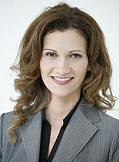
Member Morpheus Lab, 2007-2009 (Emeritus)
Dr. Sandra Ugrina received her B.S. degree in Aerospace Engineering from the United States Naval Academy in 2002 and her PhD degree in Aerospace Engineering from University of Maryland in 2007. Sandra Ugrina is currently employed by University of Maryland and is resident at the National Institute of Aerospace (NIA) conducting research on design and analysis of advanced aerospace vehicle concepts that include active flow control. Sandra’s interest in active flow control has been initiated by the growing benefits and advances in this field as it is believed that technology progress in this area will enable fuel savings, increase in payload and maneuverability, extended flight ranges and enhanced flight system safety and reliability.
As a Graduate Research Assistant Sandra performed an experimental and analytical analysis of smart material based synthetic jet actuators and their interactions with cross flows of various intensities. This interdisciplinary research area has broadened her interests from separation control and virtual dynamic shaping to laminar flow control. As a result, Sandra worked as an Airbus North America Consultant to research advanced technologies for laminar flow control applied to transport aircraft and the potential system-level benefits from synergistically integrating these technologies. She has extended her interest in this area and is currently working on a research task that is supportive of the aim to reduce the fuel burn of commercial airliners and to substantially reduce engine emissions improving the quality of the earth’s atmospheric environment.
Sandra Ugrina is a recipient of the esteemed 2008 L’Oreal-UNESCO Fellowship.
Title: Laminar to Turbulent Flow Transition Control using Lyapunov’s Direct Method
Sandra Ugrina is currently working on formulating a distributed parameter control system and a distributed parameter self sensing smart material actuator that will actively extract energy from the boundary layer disturbances and delay transition from laminar to turbulent flow. Similar design of a distributed parameter actuator and a distributed parameter control theory were used to successfully design an active vibration damper for structures. The resemblance between fluid flows and structures in that they are both systems distributed in nature and are best described by partial differential equations in the independent time and spatial variables initiated the proposed study to investigate the benefits of designing adaptive, time dependent surface patterns on aircraft surfaces to dynamically influence or damp the development of particular flow features in the boundary layer in order to delay transition from laminar to turbulent flows.